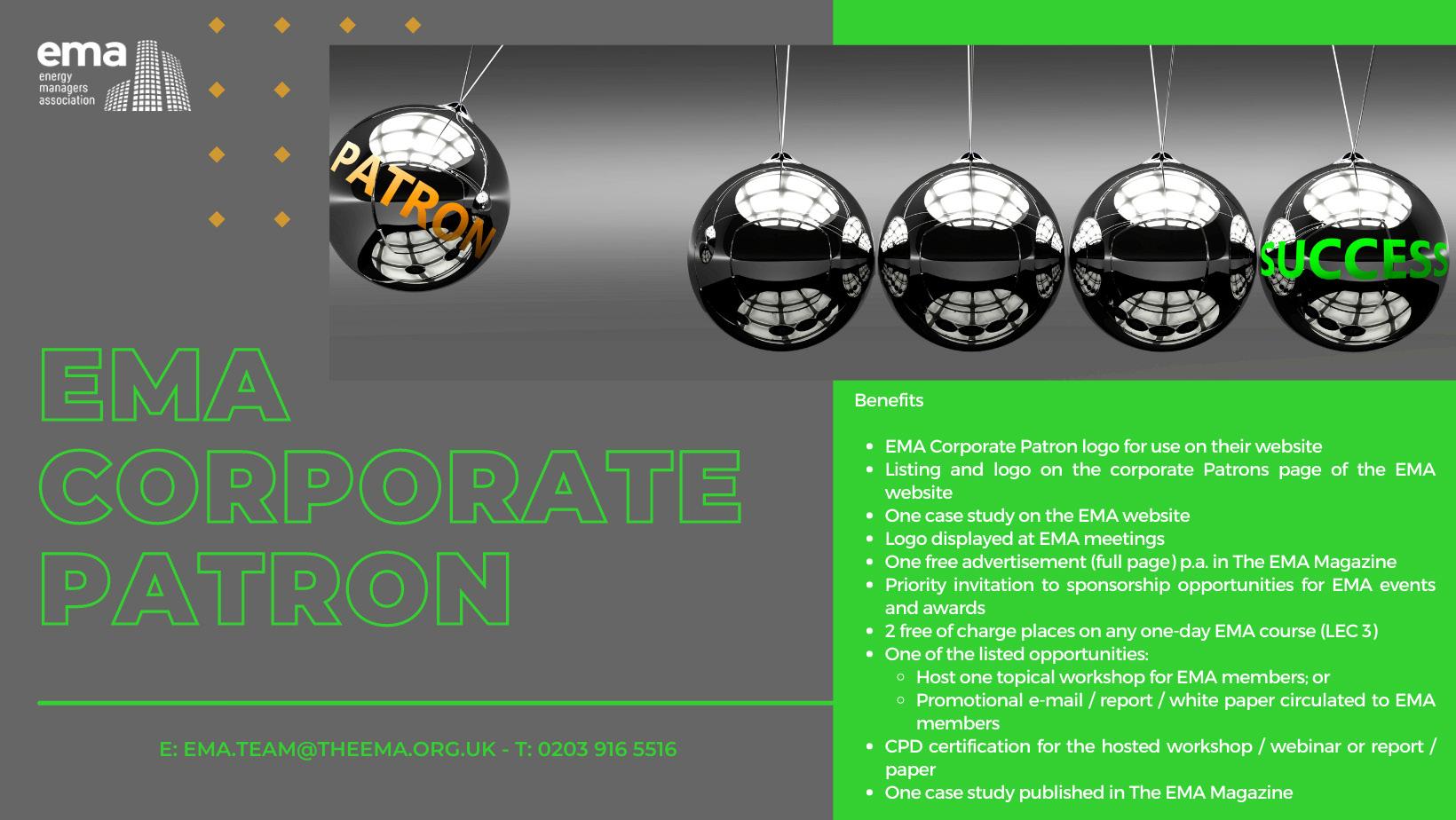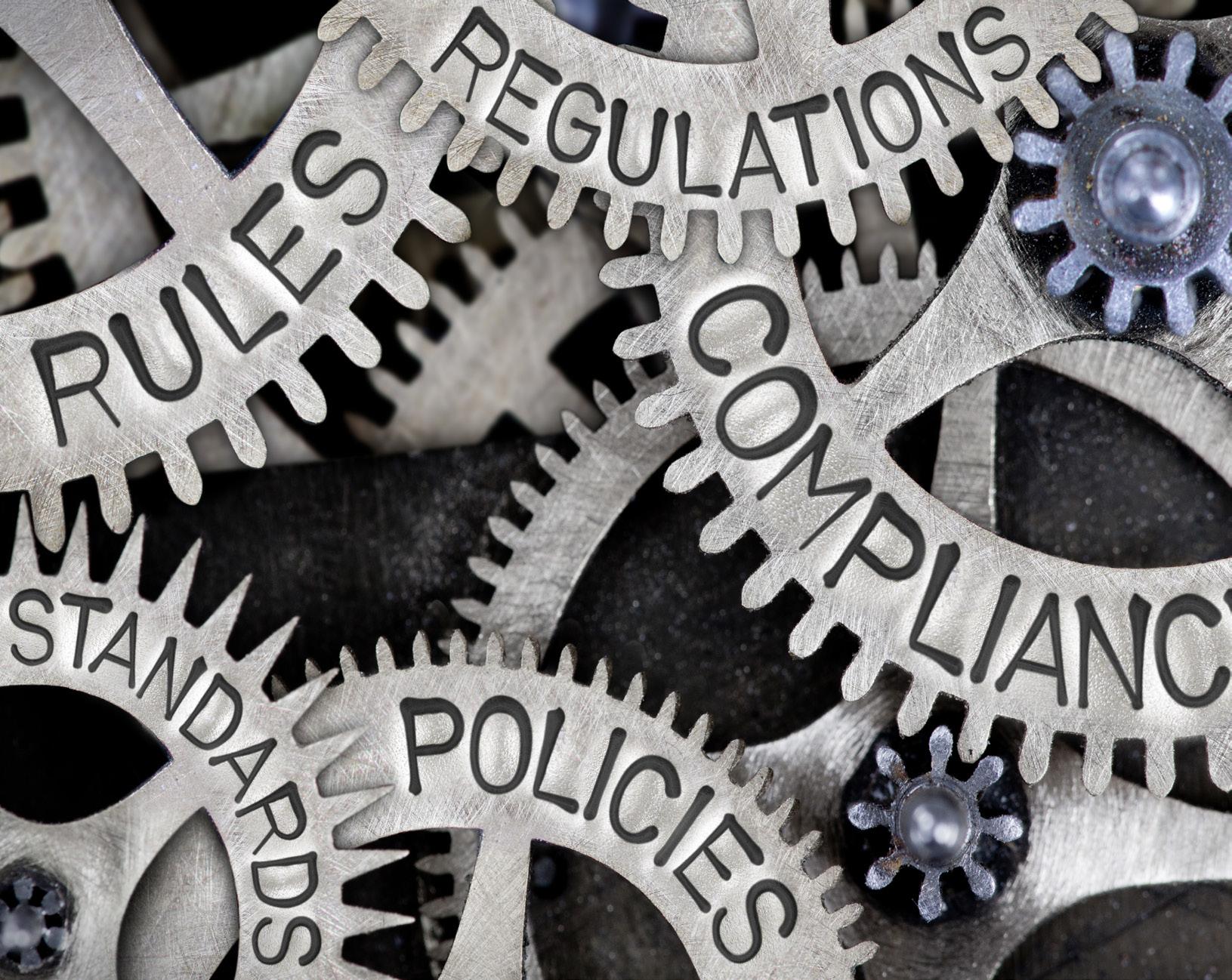
17 minute read
ENERGY MANAGEMENT – PAST AND FUTURE
“The Energy Managers Association (EMA) was set up 10 years ago this month with the aim to improve the position of energy management experts, their profession and act as their united voice. Over the years the EMA has brought together some of the most respected names in the energy management industry who have helped to shape the practical training courses for energy management professionals at any point in their career. Whilst the energy management industry is evolving and expanding, the founding principles from 10 years ago of the need for knowledge exchange, best practice, and putting energy management at the heart of British business continue to resonate todaY.
Lord Redesdale, Founder of The Energy Managers Association
Advertisement
Ben Burggraaf, Gillian Brown, Caroline Holman and Martin Gannon evaluate a decade of the energy management industry.
by Ben Burggraaf, Chairman of the EMA Board of Directors and Head of Energy Optimisation at Welsh Water

How has the energy management industry evolved over the past 10 years?
The transition of the electricity network to low carbon power generation and the associated increase in non-commodity charges have been the drivers for change in the energy management industry over the past 10 years. Historically the commodity, or wholesale, cost of energy (gas & electricity) determined over 70% of the unit cost and therefore the total energy costs of many businesses. Given the relatively high supply margin (>25%), i.e. available generation capacity versus peak electricity demand, the wholesale price was mainly determined by macroeconomic factors and the demand of electricity, which meant it was relatively predictable and could be hedged cost effectively, to provide price certainty. However, the introduction of renewables to replace oil, gas and nuclear power stations in the UK, has significantly increased the wholesale price volatility, due to supply margins dropping to less than 5% in the winter period and mismatch between the
production of renewable electricity versus peak demand, which means the industry regularly see negative prices and/or prices that rise to 10-20 times the average price. The latter means that hedging alone will not provide energy managers with the cost control needed to prevent escalating wholesale electricity costs, as managing when you use electricity and respond to the market, has become an important part of managing energy costs dayto-day. The introduction of renewables and the associated costs, to fund the associated subsidies (e.g. Renewable Obligation, FeedIn-Tariff, Contracts for Difference) and costs associated with managing the intermittency (Capacity Market, BSUOS), has also meant that most of the unit costs of electricity are now determined by the noncommodity charges. As it’s difficult or expensive to ‘hedge’ these non-commodity costs in the traditional way and costs were rising in some cases 20% year on year,


businesses had a strong incentive to start investing in (renewable) generation and energy efficient equipment, to reduce the ‘behindthe-meter’ electricity consumption, to avoid these charges and reduce exposure to future increases.
How do you see the future of the industry developing?
Given the climate emergency, the future of the energy management industry will be heavily driven by reducing organisations’ carbon footprint, whilst mitigating the potential cost impact. In many organisations, energy managers and their teams, will be assigned the responsibility to lead the decarbonisation of their organisation in a way that withstands customers’ and other stakeholders’ scrutiny. A good understanding of carbon accounting and how low-carbon electricity & gas (biomethane, hydrogen) can be sourced, in a way it’s demonstrating additionality, whilst providing value for the organisation is one of the key challenges that energy managers will face in the future. The historical issues with the Renewable Electricity Guarantees of Origin (REGOs) and other offsetting is affecting the credibility of the claimed carbon reduction. Combined with the rapidly increasing price of the REGOs and other carbon credits/offsets, following the climate emergency increasing the financially liability, means that energy managers need to develop their wider knowledge beyond the traditional commercial & technical skills & knowledge to ensure that Environmental, Social and Governance (ESG) criteria set by the organisation and strongly influenced by customers & stakeholders are met on an ongoing basis.
Author’s profile:
Ben holds a Mechanical Engineering degree from Twente University and a chartership with the Institute of Mechanical Engineers. He started his career in 2002 at Corus/Tata Steel in the Netherlands and in 2014 joined Welsh Water. In 2018, he was appointed as the Head of Energy, leading on all aspects of energy and carbon management. Ben is the current Chairman of the EMA Board of Directors on which he has been serving for the past 2 years.

How has the energy management industry evolved over the past 10 years?
I have been working in the energy management industry, specifically within the public sector, for 17 years. Whilst the public sector does not normally have the reputation of being able to move quickly and with the times, I have been lucky enough to be able to say that I have seen significant change throughout my years in the sector. When I started in this field, the role of the Energy Manager had very few similarities to the role I have today; bill validation, project works, reductions in consumption are all still the key building blocks any Energy Manager should excel at. However, in the last few years, the changes to the language used when talking about energy and its associated emissions, the scope and scale of the tasks undertaken, the enhanced focus from both internal and external parties, and the evolution of bringing historically disparate disciplines together to create a whole collective effort in our carbon challenge has been revolutionary. As Energy Managers we have had to evolve and quickly.
The drivers of these changes have varied over my career, but their commonality is that they have all become much bigger and come much faster than when I first started in the field. The cost of energy has always been and will always be the main driver for change. 17 years ago, the word cost was simply the financial outlay for the energy purchased, and as that cost grew there was an ever increasing requirement to ensure efficiencies could be made to reduce that cost. 17 years on and the word cost means so much more. Yes, the financial impact of our energy is an increasing worry for many, the price hike we have all been exposed to over the last few months is testament to that, but in the current world the cost of our energy is so much more. The reputational cost of the energy we consume and the associated carbon emissions can do as much damage to an organisation’s reputation as it can to the financial bottom line.
By reducing the reliance on fossil fuels, increasing the amount of self-generation, consuming energy efficiently and effectively, builds an image to the outside world that an organisation takes its duty to the environment and the world seriously.
This can be the difference between winning or loosing a contract, increasing student recruitment numbers or getting buy in from an external investor. If this reputational cost is ignored it may cost an organisation more than simply an extra few pence per kwh.

How do you see the future of the industry developing?
COP26 in Glasgow provided a glimmer of hope for the planet, whilst at the same time creating a tsunami of enthusiastic people, innovative technical solutions and a global shift in peoples’ willingness to act. I believe that this is the beginning of a bright and prosperous future for our industry. The future must bring change, and this must be bigger and more impactful than we have ever experienced before. Projects have to be bigger, decisions must be bolder and more people from different sectors need to be involved. Most importantly we all must work together, this must be internal to our organisations, as collectives of similar industries, at a national scale and at an international scale. If my 17 years in the industry has taught me anything it is that change is inevitable, but the direction and speed of that change is up to us.
Author’s Profile:
Gillian is a long standing energy management professional. She has expertise in the management of energy and carbon emissions from buildings of all ages ranging from small scale domestic properties to large scale hospital complexes. As well as managing the energy and carbon emissions for the 4th oldest English speaking university in the world, Gillian researches the development of digital twinning technology for the development of large scale energy reductions at building group level. Gillian is the Vice Chairperson of the Energy Managers Association Board of Directors and Chairperson of the Empowering Women in Energy Management and Environment Group.
ENERGY MARKET REPORT
Weekly analysis of the energy markets: - Forward annual gas and electricity pricing - Price drivers - Outlook commentary

Email the EMA to receive a free sample or subscribe at https://www.theema.org.uk/shop/ to start receiving the weekly up to date market information.

When asked to reflect on how the energy management industry has evolved over the past 10 years; I cast my mind back to the main events which I recall in 2012. This included DECC’s Electricity Market Reform (EMR) which was intended to drive the changes needed to underpin three key objectives, namely - keep the lights on, keep energy bills affordable (?!), and to decarbonise energy generation. In 2016, Business, Energy & Industrial Strategy (BEIS) replaced the Department for Business, Innovation and Skills (BIS) and the Department of Energy and Climate Change (DECC). While it would be disingenuous in a complex, global interconnected market to suggest that current energy wholesale market challenges can be laid at the door of EMR, or the plethora of ‘not so connected’ energy regulations since, there is an irony here somewhere! However, the three underlying principles of energy security, cost optimisation and decarbonisation still hold true, and are the foundations of robust energy management and good practice.
So what have been, in my view the key drivers for change which have influenced the energy management sector over the last 10 years?
For me personally, the requirements of the role have increased significantly in terms of skills – it is no longer just about consumption and cost, but a far broader ‘total resource’ efficiency leadership position. This in turn has, I believe increased the attractiveness of the role; and I certainly see and experience far greater diversity in my sector and professional sphere. This is extremely important as such a challenging but highly rewarding position needs to attract the very best talent from across all industries, sectors and communities. When I first started out in energy management, carbon was already a key part of the role, however over the last 10 years a number of other critical areas have emerged including, but not limited to risk management, resilience, PR, psychology, commodity trading, SMART systems (data and metering), and of course technology across the low carbon and renewable energy spectrum.
The level of acronyms has also increased exponentially, and some have been used more than once – I always thought BMS was a building management system, now I see it regularly referred to in battery management! No surprise then that my biggest daily challenge is sifting through the jargon and veneers or ‘green washing‘ and trying to engage stakeholders in a meaningful, and mutually beneficial way.
So, how do I see the future of the energy management industry developing?
In broader terms, I expect and hope for greater focus on Whole Systems Thinking around total


resource efficiency i.e. talent, skills, consumption, carbon, cash, natural capital, technology, communities, sectors and policy. This should be ably supported by established and emerging technologies, Artificial Intelligence (AI), smart systems and analytics.
However, without collaboration and a whole systems approach, the benefits will be undermined and ‘unintended consequences’ may well distract efforts away from understanding and addressing the broader climate and environmental objectives. We need to embrace the role of new technologies and advanced modelling and analytics to secure new levels of intelligence, while aligning comprehensive environmental stewardship with delivery of efficiency objectives.
Energy Managers must continue to pursue greater transparency, accountability and responsibility - engagement versus ‘expert view’. We must bring on board advocates across all sectors including communities - remove jargon, smoke and mirrors and be honest and up front. A robust and agreed plan which all stakeholders understand and support, delivering 80% progress, is better than 100% ambition with no plan or advocacy to get there!
There must be focus and attention on reducing the gap between home and work – awareness of consumption, personal responsibility, etc. Which begs the question - Will the many positive lessons from the pandemic be truly evaluated and applied where appropriate?
As I reflect on the last ten years and the role of the EMA in continuing to uphold high levels of professional conduct, development, standards and the real word application of sound energy management principles, I continue to circle back to ‘my’ two universal truths:
1. Measure to understand, prioritise and action…
2. Good energy management is about the whole system and the interdependencies across People; Process; Environment; Carbon and Cost. Focus on one or two elements in isolation at your peril!
Author’s Profile:
Caroline is a Chartered Environmentalist with the Institute of Environmental Managers & Assessors (IEMA), Fellow of the Institute of Engineering Technology (IET), and Board member of the Energy Managers Association (EMA). She has over 30 years’ experience, predominantly in the automotive sector. Her various roles have included engineering, manufacturing, supply chain, sustainability & CSR, project management, energy strategy & policy, carbon, and utilities risk management.

How has the energy management industry evolved over the past 10 years and what were the drivers for change?
I have spent the past forty years working in the Steel Industry in various engineering roles across production areas, primary melting, rolling / finishing and service departments including, high voltage, electrical services / workshops, and project development. I moved into an energy management role in 2010, the role has certainly changed and evolved over the past twelve years. Looking back at the early days, the drivers for energy efficiency in the Steel Industry were rising energy costs and price disparity, with Government policy in the form of Steel Sector Climate Change Agreements and participation in the EU Emissions Trading Scheme also driving change. As technology quickly developed and became more affordable, ’the low hanging fruit’ of LED lighting schemes and controls, Variable Speed Drives and high efficiency motors, pumps drives and fans, compressed air systems, leaks, efficiency, hydraulic systems and controls were adopted along with new metering, monitoring and targeting systems. The improvements and savings drove interest and ownership from plant and managers helping to drive behavioural change.
Within my Industry, the Energy Manager’s role moved under the environmental function, as an Energy Intensive Industry, we work closely with Make UK / UK Steel and the Energy Intensive Users Group to lobby Government on energy pricing and policy. We secured the EII compensation scheme and the additional reporting requirements this brought.
With the drivers of energy price and continuing Government Policy changes, reporting began to play an ever-increasing role for the Energy

Manager, with EUETS (now UK ETS) and Greenhouse Gas reporting requirements along with the mandatory external audit and verification of data.
The Phase 1 ESOS audit requirement and other subsequent phases have helped to drive the Energy Manager and energy from plant room into the board room and put energy costs and efficiency at the forefront of business decisions with the reports and recommendations being presented and signed off at Board level.
The Streamlined Energy and Carbon Reporting requirements brought in two years ago has also strengthened the role of the Energy Manager in the Board room with the requirement for disclosure of the site energy, fuel consumption and carbon intensity in the annual business accounts.
With the increased awareness of ‘climate change’ and ‘carbon’, customers started to ask about the Energy Intensity and carbon associated with the product, this has led to production of EPDs and LCAs for products and process routes and the certification and ongoing assessment to different ‘sustainability standards’, UK CARES and BES6001. Over the years, advantage has been taken of any available Government schemes, EDR (Electricity Demand Reduction), IHRS (Industrial Heat Recovery Support programme), TFI (Transforming Foundation Industries - UKRI). These schemes have helped to part fund installation and the proving of new technologies, requiring the Energy Manager to adapt and learn new skills in the complexities of applying for the funding and the management of the schemes with their complex reporting requirements.
How do you see the future of the industry developing?
The drivers of change have been continually evolving, with energy price and Government policy still significant, the emergence of climate change and COP commitments are now business issues focussing the drive for carbon neutrality and sustainability. This driver has rapidly changed the focus of business strategy and the role of the Energy Manager, businesses are now faced with the challenge of carving a path to carbon neutrality or net zero with the Energy Manager playing a pivotal role in setting out the pathway. The energy management industry continues to undergo rapid change, with the energy grid mix being driven by the net zero and carbon neutrality targets, non-fossil fuel technologies are being developed to meet the challenges of industrial and domestic heat decarbonisation with Hydrogen beginning to play a role along with Carbon Capture, Usage and Storage (CCUS) and other emerging technologies. The future certainly looks challenging for the modern Energy Manager as we strive for carbon neutrality and net zero.
Author’s Profile:
Martin has worked in the Steel Industry for over 40 years, he is a Dynamic Chartered Engineering Manager with extensive maintenance, project management, process innovation and team building skills. He is a Member of the IET and became a Chartered Engineer in 2000, he is a registered IET Mentor, supporting and coaching young engineers and apprentices. He is a Lead ESOS Assessor, a Fellow of the Energy Managers Association and has been a Board Member for the past two years.

10 YEARS OF THE EMA

2012
FIRST PRACTICAL GUIDES ARE DEVELOPED 2013
EMA ENERGY MANAGEMENT AWARDS LAUNCHED JUNIOR ENERGY MANAGER APPRENTICESHIP STANDARD APPROVED NAMED AS THE NATIONAL ADMINISTRATOR FOR THE EUROPEAN CODE OF CONDUCT FOR ENERGY PERFORMANCE CONTRACTING
EMPOWERING WOMEN IN ENERGY MANAGEMENT AND ENVIRONMENT GROUP LAUNCHED TAILORED IN-HOUSE TRAINING LAUNCHED
2014
APPROVED AS AN ESOS LEAD ASSESSOR REGISTER
2015
2016
EMA CORPORATE PARTNERSHIPS LAUNCHED
EMA RECOGNISED ENERGY MANAGER STATUS LAUNCHED
THE EMA MAGAZINE LAUNCHED
LEC ENERGY MANAGEMENT TRAINING PROGRAMME LAUNCHED
2017
KNOWLEDGE PARTNERSHIP LAUNCHED
2018
TAILORED IN-HOUSE TRAINING ABROAD LAUNCHED
2019
2020
ONLINE PROFESSIONAL DEVELOPMENT LAUNCHED
STEERING GROUP LAUNCHED 2021






